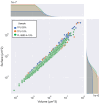Radiopaque Polyurethanes Containing Barium Sulfate: A Survey on Thermal, Rheological, Physical, and Structural Properties
- PMID: 39518294
- PMCID: PMC11548690
- DOI: 10.3390/polym16213086
Radiopaque Polyurethanes Containing Barium Sulfate: A Survey on Thermal, Rheological, Physical, and Structural Properties
Abstract
Radiopaque polyurethanes are extensively used in biomedical fields owing to their favorable balance of properties. This research aims to investigate the influence of particle concentration on various properties, including rheological, radiopacity, structural, thermal, and mechanical attributes, with a thorough analysis. The findings are benchmarked against a commercial product (PL 8500 A) that contains 10% weight barium sulfate. Two more thermoplastic polyurethanes (TPU) were formulated with two different concentrations of barium sulfate (10 wt.% and 20 wt.%) and compared to the commercially available product. FTIR demonstrated similar absorption bands among all samples, indicating that the fabrication method did not impact the TPU matrix. DSC indicated a predominantly amorphous structure for PL 8500 A compared to the other samples, while the kinetic degradation was more influenced by the higher barium sulfate content. The rheological analysis showed a decrease in the complex viscosity and storage modulus with the radiopacifier and an increase in the radiopacity, as demonstrated by the X-radiography. X-ray microtomography showed a more spherical particle format with a heterogeneous particle structure for PL 8500 A compared to the other polyurethanes. These findings enhance the comprehension of the structure-property relationships inherent in these materials and facilitate the development of customized materials for targeted applications.
Keywords: barium sulfate; biomedical applications; polyurethane; radiopacity.
Conflict of interest statement
The authors declare no conflicts of interest.
Figures













References
-
- Farag M.M. Recent trends on biomaterials for tissue regeneration applications: Review. J. Mater. Sci. 2023;58:527–558. doi: 10.1007/s10853-022-08102-x. - DOI
-
- Can A., Zengın B., Gokceoglu C. Comparison of Plaxis-2D and 3D Models of Improved Ground with Deep Mixing Columns. In: Wang S., Huang R., Azzam R., Marinos V.P., editors. Engineering Geology for a Habitable Earth: IAEG XIV Congress 2023 Proceedings, Chengdu, China. Environmental Science and Engineering; Singapore: 2024. IAEG 2023.
LinkOut - more resources
Full Text Sources

